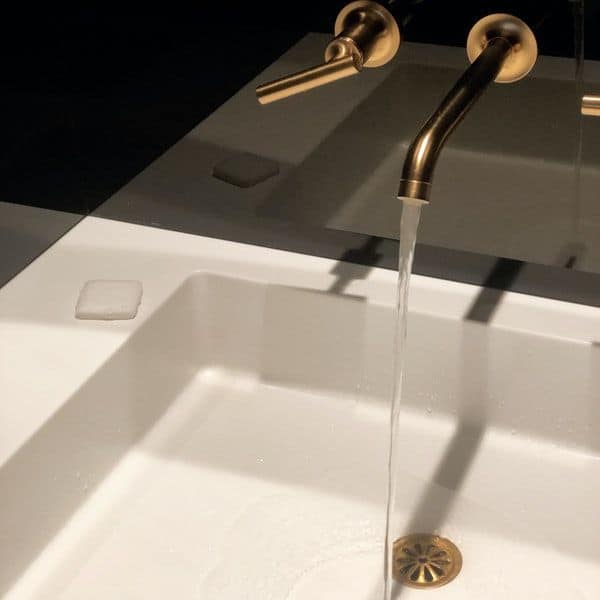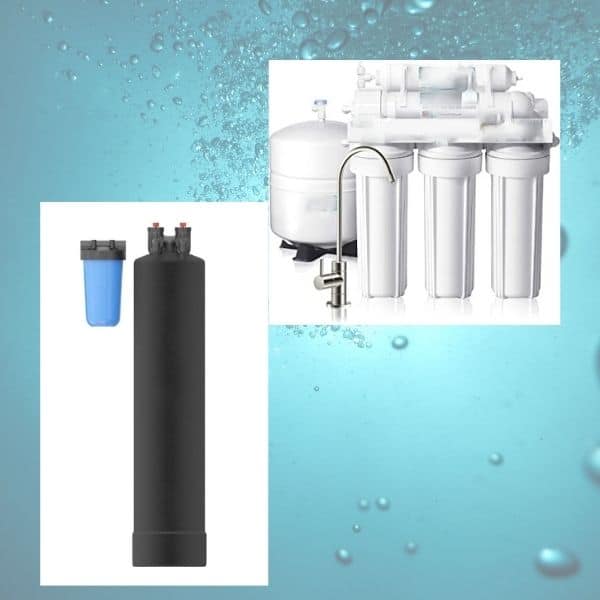3 Effective Ways to Remove Limescale From Water
There are several ways to reduce limescale from water. Here we have listed three effective ways that you can apply either to remove or to prevent limescale build-up in your home.
Ion Exchange
Ions of minerals, calcium, and magnesium are responsible for the build-up of limescale. These ions form carbonate of their respective ions, resulting in limescale in water.
The ion exchange method swaps calcium ions with sodium ions, making the water salty and removing the limescale.
The process is simple. You pass water through strong acidic cation (SAC) resin beads that enable the exchange of calcium ions with sodium ions to reduce the hardness of the water, making it slightly acidic. Well, the naturally soft water is like mild acid, too.
Reverse Osmosis
Reverse osmosis is one of the cleanest ways to remove contaminants from the water. In RO, we use a membrane with tiny pores to block the flow of chemicals causing contamination of water.
For instance, calcium, magnesium, lead, fluorine, etc., are blocked during Reverse Osmosis to make the water clean and pure.
The only shortcoming of RO is that it makes the water taste flat. The water also lacks any healthy minerals since RO systems removes every chemical, including beneficial minerals.
Lemon Juice
Preventing limescale accumulation in your coffee maker and washing machine is not easy. The first and logical method is to treat the hardness of the water. It will prevent limescale buildup. But for removing limescale build-up that is already present you need a strong acid like white vinegar or lemon juice.
Run the white vinegar solution or lemon juice through the water compartment of the coffee maker and then rinse it with plain water. Repeat the process twice or thrice. For heavy limescale deposits on ceramic toilets, scrub white vinegar or lemon juice with an old toothbrush or pumice stone. Soaking for about an hour before rinsing or scrubbing is also useful.
What is Limescale?
Before we learn about limescale, we must clear our minds about hard water. Well, water has two types based on the constituent minerals. For instance, if the water is free from calcium and magnesium ions, we call it ‘Soft Water.’ On the contrary, the water that contains them as a part of it is said to be ‘Hard Water.’
Limescale deposits are produced because of hard water. It is because of the minerals that deposit on the surface after the water evaporates. Since it has a larger quantity of minerals, the evaporation leaves a white or green crust on the surface.
Mostly, limescale is a solid form of minerals that remains due to heating the minerals-containing water.
Source of Limescale Contamination
Well, the source of limescale is hardening minerals found in water, such as magnesium and calcium. These minerals remain as a deposit on the surface of the household appliances upon heating.
You may wonder where these mineral deposits come from in water? It occurs when the rainwater passes via rocks rich in water, hardening minerals; water absorbs them, and these dissolved minerals turn soft water into hard water.
The hardness of water later causes limescale that weakens the quality of appliances, such as washing machines, coffee machines, tea kettles, etc.
Various magical magnets sold in hardware stores are used to soften the hard water. They claim to use magnetic force to draw out ions. But according to lab testing, they are not effective.
The Symptoms and Odds of Limescale
Limescale is a naturally occurring by-product of water that can devalue your home appliances and cost you a substantial financial loss by the need for maintenance.
The symptoms of limescale are none more than a whitish or greenish layer in the water reservoirs. For instance, when you heat water in a pot, and you see a white solid layer on the walls of that pot, that is what we call limescale.
Limescale in water is dangerous. Let’s talk about its odds and dangers:

Reduction In Appliances’ Efficiency
As limescale is a solid form of minerals. It accumulates on the walls of the pipes, taps, showerheads, and other appliances. This way, the lines are obstructed, which causes a loss of water pressure.
Consequently, extra power is used due to the reduction in efficiency resulting from limescale.
Health Concerns
Limescale has a proven negative health impact. It is one of the significant factors for increasing bacteria growth inside the pipes that circulate drinking water.
The consequence of this dangerous bacterial growth creates a high concentration of biological problems in the human body.
Moreover, hard water is rich in minerals that can be a significant cause of kidney stones and blood pressure issues for the human body, especially for heart problems. It also results in dull hair and dry skin.
Increment In Financial Burden
Limescale reduces the quality of pipes and causes a substantial financial loss in repairing the plumbing system and replacing the impacted appliances. It heightens up the heating cost as more energy is required due to reducing efficiency.
Hard water reduces the effectiveness of detergents and increases your clothes’ washing cost.
Does Water Filter Remove Limescale?
A limescale water filter functions to provide soft water and lets you get rid of limescale in tap water. Water filters are helpful to soften tap water in places where hard water is found.
Many water filters use the latest technology to ensure efficient limescale removal. The filters are equipped with technology based on removing scale-forming calcium from the water to prevent or treat limescale in water.
There are many water filters, ranging from salt-based water filters, salt-free water filters, and electronic descalers. They work differently but function in common in removing limescale from water.
Which Water Filters Remove Limescale?
Removing limescale means eliminating the mineral ions that serve as roots of the problem. Here are some of the best water softener systems for you.
Salt-Free Water Softener
Unlike the ion exchange method, salt-free water filters employ another technique that does not exchange hardness ions with sodium ions. Instead, they are equipped with TAC (Template Assisted Crystallization) technology to neutralize water without removing hardness ions.
It uses potassium instead of potassium. Potassium helps in the crystalization of minerals. Salt-free water softeners do not need constant maintenance.
In this way, a salt-free water softener eliminates the issues that hard water might create with your plumbing systems with less maintenance.
Portable Water Softener
A portable water softener is an excellent option for people who love traveling. This water softening system is the answer if you want a filter that works without electricity and rigorous upkeep.
Portable water softeners work based on the use of salt. It is excellent for quick filtration of tap water. However, there are some drawbacks, too. It can provide you with softened water for a small number of users only.

Showerhead Water Softener:
A shower head water softener is an economical water filter that can benefit you in many ways. You don’t have to clean the whole house. Instead, you can replace your old shower heads with it and enjoy the perks of soft water in your bathroom.
This filter is affordable and very easy to install. It is the most accessible and economical way to clean the water. So, no more limescale in your bathroom water supply. Consequently, no more dull hair and damp skin.
FAQs on How to Remove Limescale From Water?
How do I know if my house is contaminated with Limescale?
You can find out the limescale deposits in your house by looking at places with water flow. It is a white, chalky residue and crusty build-up around water spots.
Limescale is usually found on a toilet bowl, taps, bathroom walls, and sinks. Other wet areas can also have limescale deposits. Limescale can also has rust-like color.
Does boiling water remove limescale?
Boiling water is effective in removing temporary limescale. Dissolved calcium hydrogen carbonate is responsible for the cause of temporary limescale, and with one hour boil, you can remove it.
The boiling of water disintegrates the soluble calcium hydrogen carbonate into carbon dioxide and insoluble calcium carbonate and water. You can simply filter this undissolved residue.
Does distillation remove limescale?
Yes, distillation is a practically effective phenomenon that removes most of the water contaminants. It can remove pollutants, ranging from hardness compounds like calcium, magnesium, and sodium.
Unless the boiling point of the contaminants is lower than water, distillation will be productive in removing them.
Conclusion
The removal of limescale is crucial because it functions to heavy your pockets. It causes the decay of your home appliances and increases the need to call a plumber.
Besides these impacts, it also has adverse effects on your body, including the skin, hair, etc.
We hope that our guide has answered your query on how to remove limescale from the water. We encourage your feedback.
